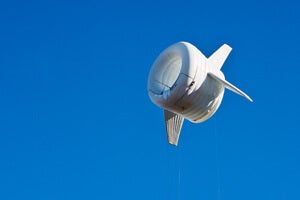Singularity Surplus: Put on Your Electric Thinking Cap!
Brain stimulation leads to faster learning; TED marks 30th anniversary with giant digital art display; flying wind turbine poised for test run in Alaska.

Share
Advances in exponential technology happen fast — too fast for Singularity Hub to cover them all. This weekly bulletin points readers to significant developments to keep you in the know.
Electricity Makes You Smarter
The medial-frontal cortex is the brain’s inner critic, spiking activity when we discover we’ve made a mistake. Because learning from mistakes is in a sense the most basic form of learning, Vanderbilt scientists were interested to see if stimulating the area with an electrical current would make people quicker studies. Subjects who received an anodal current from the crown of the head down to the cheek mastered a learning task more quickly than average. Those who received the reverse current were slower on the uptake. So if you grab an electric thinking cap, just be sure to put it on the right way.
Be Part of the Future
Sign up to receive top stories about groundbreaking technologies and visionary thinkers from SingularityHub.


It's a Bird, It's a Plane, It's a Flying Wind Turbine!
Solar power has taken off faster than wind power thanks to free-falling prices. Wind power companies are looking for ways to boost efficiency and lower fixed costs. Flying wind turbines could be one way to prune outlays for land, construction and underground supports. The wind is also higher and more consistent at 1,000 feet, the altitude at which the highest flying turbine to date will soon float above Fairbanks, Alaska, tethered to earth by cables that transmit electricity. The turbine will provide energy during an 18-month trial period to rural residents who currently use diesel generators.
And the Smartphones’ Red Glare …
To celebrate the 30th anniversary of the TED conference at its recent meeting in Vancouver, Canada, public artist Janet Echelman and Aaron Koblin, Google’s head of data arts (yes, apparently the company has one of those), created a giant crowd-sourced piece of digital art. Conference attendees could use their mobile devices to paint beams of light that displayed on a "canvas" made of 745-feet of ropes fastened to two city buildings. The displayed content was actually a single full-screen Google Chrome window 10-million pixels wide in which users could create content in real time.
Cameron received degrees in Comparative Literature from Princeton and Cornell universities. He has worked at Mother Jones, SFGate and IDG News Service and been published in California Lawyer and SF Weekly. He lives, predictably, in SF.
Related Articles

Hugging Face Says AI Models With Reasoning Use 30x More Energy on Average

How Scientists Are Growing Computers From Human Brain Cells—and Why They Want to Keep Doing It

These Brain Implants Are Smaller Than Cells and Can Be Injected Into Veins
What we’re reading




